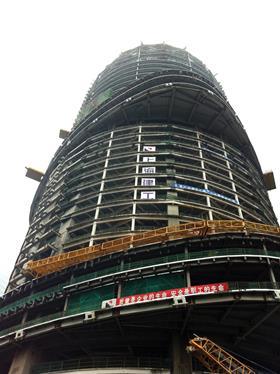No country is changing at such a mind-boggling pace as China - now the largest construction market in the world and with new cities sprouting up all over the land. So is this the right time to be trying to muscle in on the market - or will fears of a crash and a highly protected sector ward off UK companies? Sarah Richardson reports from China

Peering upwards into the Shanghai fog, on a chilly late winter’s morning in the city’s Pudong district, the latest floors on what will be China’s tallest structure are just visible through the haze.
Fifty floors high now, by the time the Gensler-designed Shanghai Tower reaches its full complement of 121 levels, it will stand at 632m, making it the dominant tower on a skyline already packed with extravagant symbols of the city’s dramatic development over the last 15 years: the crystalline Jin Mao tower, the brash and overpowering Oriental Pearl Tower, and the 492m high Shanghai World Financial Centre.
There is no doubt that Shanghai, and China more generally, has run entirely counter to the international downward spiral of development work over the past four years. China’s annual construction market has shot up in value from £200bn in 2007 to around £500bn in 2011, and in 2010 overtook the US to become the world’s largest construction market with 15% of global work. According to a report by Global Construction Perspectives that figure is expected to rise to 21% by 2020.
Much of this anticipated growth is expected to come from China’s second and third tier cities, with the central government seeking to encourage development in central and western China to ease the pressure on space and resources in the more developed eastern coastal regions such as Beijing, Shanghai and Guangzhou.
But over recent months, increasing signs of caution have crept into the outlook for China’s development sector, with some commentators fearing that the country is heading for a so-called “hard landing” from its economic boom. Meanwhile, the Chinese government has taken steps to cool the overheated housing market by placing new restrictions on home ownership in major cities, which has already hit investment in the residential sector.
So how much confidence should really be placed in the future of China’s construction market? And how much opportunity is there for western firms tempted to muscle in on a market which, despite all the barriers to entry of a heavily state-controlled sector, has also, as it has grown, often coveted international glamour and western technical expertise?
China’s need for construction
China’s construction sector has enjoyed dramatic expansion since the eighties, when the government identified it as central to the country’s economic growth. On top of the government’s desire to create a stronger industrial and commercial infrastructure, demand has been fuelled by China’s need to support a burgeoning population. The mainland population at the end of 2011 stood at 1.3bn, almost 20% of the population of the world. This was a rise of 6.44 million on 2010, despite a flat birth rate.
This has resulted in a continued demand for residential, social infrastructure and transportation projects, the need for which has been increased further by a trend towards urbanisation. By the end of 2011, for the first time more than half of China’s population - 51.27% - was living in urban areas rather than rural, according to China’s National Bureau of Statistics.
These inherent drivers of construction growth are backed by key policies in China’s 12th Five Year Plan, which outlines the government’s political and spending priorities for the period 2011-15. The plan is centred on a desire to increase urbanisation still further - the government wants to create 260 new cities in the coming 20 years - and to open up China’s second and third tier cities for trade and investment.
In tandem with this, the government wants to redistribute China’s industrial base so that manufacturing plants are no longer so greatly concentrated in western and central areas, creating more balanced communities and reducing the problem of industrial pollution.
The need to reduce pollution in itself also provides a potentially strong boost for construction growth. In December 2009 the Chinese State Council committed to reducing its carbon intensity - carbon dioxide emissions per unit of GDP - by 40% to 45% by 2020. The five-year plan identifies a more sustainable built environment - including a retrofit programme - as a key contributor to achieving this target. In addition, the plan commits to a series of major renewable energy projects, including the construction of six onshore and two coastal and offshore large wind power projects, and the construction of a series of solar energy power stations with a total generation capacity of over 5 million kW.
Such an obvious need for investment, and the strength of the government’s commitment, has fuelled confidence among many about the future possibilities for construction in the country. Stephen Lai, managing director of Rider Levett Bucknall Hong Kong, which is acting as cost consultant on the Shanghai Tower, says: “We think that there will be a lot of work for the next 10 to 20 years. The second tier cities are seeing a lot of development, and the first tier cities may be slowing but they aren’t stopping.”

Economic concern and construction
Despite this, however, there have been rumblings of concern that China’s boom may go bust, posing a strong risk to its development pipeline. China’s statistics bureau recorded a slowing of growth to 9.2% in 2011 from 10.4% in 2010, and late last year the International Monetary Fund warned that the escalation of the economic crisis in Europe could slash China’s economic growth, advising Beijing to prepare stimulus measures in case this happened.
Chinese vice-president Xi Jinping, on a visit to the US-China Economic Trade Cooperation Forum in Los Angeles last month, moved to address the fears, saying: “China’s economy will maintain a steady and robust growth. There will not be a so-called hard landing.”
Yet fears about a crash in development work have been stoked by the impact of government policy towards residential development. In an effort to cool house prices in some cities, including Shanghai, the government last year increased the minimum down payments on homes. It also limited the number of houses families can purchase in certain cities, as the Chinese preference for investing in property over its fledgling stock market has led to some families buying multiple homes that then stand empty for years. Following this, China’s National Bureau of Statistics recorded that 52 out of 70 major cities that it monitors saw property prices drop between November and December 2011, and 48 out of 70 experienced a drop between December 2011 and January 2012.
Daneo Shen, associate director at consultant Sweett, says: “In some cities, because of the government policy, the [residential property] prices are nearly 20% down. So developers and investors are slowing down construction, and it has affected work in the residential sector a lot until now.” But he still believes that the industry will go up in the second half of this year because “the demands in the residential market are still at a high level and the residential sector is near to the bottom point now”.
However, although the policy will hit residential work in developed cities in the short to medium term, there is a broad consensus that the Chinese government will not allow the correction to go too far. Barry Piper, Asia director at Faithful + Gould, says: “There is a bubble, and there are inflation issues. But I don’t believe it will pop. The government appears to have robust plans to keep the economy stable.” In fact, Piper adds, the fact that the Chinese government can intervene in this way is a strong guarantee against a sudden crash. “It’s a planned, controlled economy.”
And experts argue that although the residential sector may be cooling, opportunities elsewhere are on the rise. Beijing and Shanghai are still seeing growth in commercial work, albeit at a far reduced pace, and second tier cities such as Chongqing are seeing a higher demand for quality commercial space as businesses seek to establish themselves away from the
high-cost bases of the most developed areas.
Much of the demand for office space is from foreign clients; however, the growth of Chinese domestic businesses means that these are increasingly driving development. Michael Kwok, director at Arup, which has seven offices in mainland China, says: “About 70-80% of our clients on buildings are foreign investors, particularly from other Asian areas such as Hong Kong and Singapore. But I think that balance will become more local. Both areas of demand are growing, but the local growth rate is higher.”
Another area enjoying a high level of spending is infrastructure development. This is happening on a national scale, as the government seeks to create better links between its rapidly increasing number of cities. Around 60 airports are to be built during the current five-year plan period, and despite slowing its high-speed rail programme following a fatal crash in Zhejiang province last year, the rail ministry is still spending 400bn RMB (£40bn) this year. Xiaobing Zhu, regional director for transportation in China at Aecom, says that the rail market will continue to offer opportunity: “Schemes will be built, but more slowly,” he says. “Quality is the top priority.”
There are also major opportunities in local “transport orientated development”, where new metro lines or local airports are used as a cornerstone for major mixed use schemes.
Opportunities for western firms
Despite the apparent allure of its pipeline of work, the construction sector in China remains relatively protected by the state, meaning that there are heavy restrictions on the extent of work that can be carried out by foreign firms.
Virtually all contracting work is carried out by Chinese companies, many of which are still fully or partly owned by the government. The major opportunities for western companies lie in consultancy or design, but even here there are legal limitations on the work that can be carried out. The final stages of a project’s design, for example, can only be drawn up by firms with a local licence - which are extremely difficult to obtain for firms that have entered the market from overseas. As a result, architects operating in the country generally carry out early design work and pass the project to a local design institute before it reaches construction drawing stage.

Despite this barrier to entry, however, there remains a hefty appetite for western design, particularly on signature projects. Foster & Partners, SOM and KPF have all designed signature projects in China, although architects working in the region say that increasingly practices are having to prove what else they can bring to a scheme, rather than their brand alone. Francois Thibaudeau, associate at TFP Farrells, says: “Initially, the Chinese thought the moon looked better in the west. They still want that design vision, but they’ve also realised that western expertise can provide better buildings.”
China is looking to western firms for technical expertise in areas which its domestic industry, having developed so quickly, still has not had a chance to grasp, fully or at all. This sometimes relates to particular forms of construction - for example, expertise in steel frame, a skill sought by second tier cities seeking to build high-rise buildings for the first time.
There is also an emerging demand for project management, a relatively new phenomenon in China, as projects become more complicated. Mark Budden, whose Shanghai and Beijing-based project management firm MBPM was bought by EC Harris in 2011, and who is now a partner at the consultant, says: “At the moment, ‘value’ is ‘cheap’ - it’s all about lowest price - but that is changing. Project management evolved in the west as architecture became more creative and projects more complex, and we will see that happening here.”
sustainability is another area in which China is keen to learn from the experience of the west. Helena Fu, director of Aecom China Sustainability Center, a think tank the company set up a year ago to meet the growing demand for sustainability advisory and consultancy services in the country, says: “China has been very interested in worldwide best practice. That’s proven valuable for companies like ours, as we can combine the technical and global expertise from the breadth of projects we have throughout the world, with our local know-how and understanding of the Chinese market.”
Of the western firms already operating in China, those that report strong demand for their services are often multidisciplinary consultants. They can combine areas of design and management expertise whereas Chinese competitors can often only provide a single service. Arcadis’ purchase of EC Harris was driven in part by its desire to increase its strength and service offering in China, and Faithful + Gould, part of the Atkins group, is predicting that more than 20% of its revenue will come from Asia by 2016.
These firms, it seems, are undettered by market jitters: even with a correction, the scale of the opportunity in China means it is viewed as a sound target. As Baet Yeok Hoon, a senior associate director with Atkins in Shanghai, says: “There is real pent up demand, even if there are questions over how supply works with that demand. But this isn’t somewhere like Dubai: there’s a real population here, and the market has a long way to go.”
£500bn
Annual construction spend
260
New cities in next 20 years
21%
Of global construction market by 2020

THE CHINESE MARKET
Building’s forthcoming White Paper Winning Work in China will offer full analysis of market outlook, providing an indepth guide to market opportunities and risks.
For more information and to preorder, visit www.building.co.uk/whitepapers
Ecobuild China 2012 April 9-12 2012
The Ecobuild conference is launching in Shanghai in April, providing expert advice on sustainable development opportunities in China. For information, visit www.ecobuildchina.com or email james.blue@ubm.com



























No comments yet